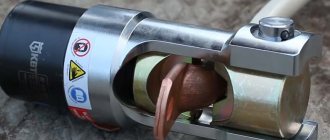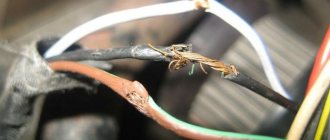Electrical hand tools, or simply power tools, include power tools with an electric drive motor. The range of such devices is quite wide; they are used to perform various operations.
Testing of portable power tools to safety standards should be carried out on a regular basis. Power tools are typically held in the hands during operation and therefore pose a potential electrical hazard.
Power sources for power tools can be:
- industrial frequency electrical networks with voltages of 380, 220, 110 volts;
- high-frequency current sources designed to power power tools of the corresponding type;
- DC sources - batteries, rectifiers and converters.
Frequency of testing power tools
We bought several drills and four grinders for work; we have a small construction and repair business. And then someone advised us to carry out some kind of testing of this power tool, and the phrase also sounded like, the frequency of testing the power tool. But of course, it never occurred to anyone to ask again, but now we are asking ourselves whether it is necessary to carry out some tests on the power tool we purchased, and if so, what is this based on?
Of course, there are rules that cannot be ignored, these are inter-industry rules on labor protection (safety rules) when operating electrical installations, here is a copy of an excerpt from this rule, which relates specifically to your topic. read carefully.
pot r m-016-2001 rd 153-34.0-03.150-00
10.7. hand-held electrical machines, portable power tools and lamps, auxiliary equipment issued and used in work must be checked and tested within the time limits and volumes established by the guest, technical specifications for products, current scope and standards for testing electrical equipment and electrical installation devices. To maintain good condition, conduct periodic tests and inspections of hand-held electrical machines, portable power tools and lamps, auxiliary equipment, a responsible employee with group iii must be appointed by order of the head of the organization.
rules for the technical operation of consumer electrical installations (approved by order of the Ministry of Energy of the Russian Federation dated January 13, 2003 No. 6)
3.5.10. to maintain good condition, conduct periodic checks of portable and mobile electrical receivers, and auxiliary equipment for them, a responsible employee or employees with group iii must be appointed by order of the consumer’s manager. These employees are required to keep a log of inventory records, periodic inspection and repair of portable and mobile electrical receivers, and auxiliary equipment for them. 3.5.11. Portable and mobile electrical receivers and auxiliary equipment for them must be subject to periodic inspection at least once every 6 months. the results of the inspection are reflected by the workers specified in clause 3.5.10 in the inventory log, periodic inspection and repair of portable and mobile electrical receivers and auxiliary equipment for them. 3.5.12. The scope of periodic inspection of portable and mobile electrical receivers and auxiliary equipment includes: external inspection; check idle operation for at least 5 minutes; insulation resistance measurement; checking the serviceability of the grounding circuit of electrical receivers and auxiliary equipment of classes 01 and 1. 3.5.13. During operation, portable and mobile electrical receivers and auxiliary equipment for them must be subject to maintenance, testing and measurements, and scheduled preventive maintenance in accordance with the instructions of the manufacturers given in the documentation for these electrical receivers and auxiliary equipment for them.
labor safety in construction
part 1. general requirements
7.4.38. tools used in construction, the building materials industry and the construction industry must be inspected at least once every 10 days, as well as immediately before use. a faulty tool that does not meet safety requirements must be removed.
I don’t know about the rules, but I firmly understood for myself in my deep youth (I myself work in the same field with power tools) that all the tools you work on, no matter whether they are new or old, must be carefully inspected at least once in 8 days. I just witnessed a faulty tool almost lead to the death of a person. And before work, in the intervals between major inspections, it doesn’t hurt to at least simply inspect your working power tool. You shouldn't joke with life.
According to ch. 3.6. PTEEP “Guidelines for testing electrical equipment and devices of electrical installations of Consumers”, the timing of tests and measurements of parameters of electrical equipment of electrical installations is determined by the technical manager of the Consumer on the basis of Appendix 3 of the Rules, taking into account the recommendations of factory instructions, the state of electrical installations and local conditions. The frequency of tests indicated for certain types of electrical equipment is recommended and can be changed by the decision of the technical manager of the Consumer.
The acceptance test standards must comply with the requirements of Section 1 “General Rules” of Chapter 1.8. “Acceptance Test Standards” of Electrical Installation Rules (seventh edition).
Read also: Do-it-yourself pipe chain wrench
In accordance with PTEEP (Appendix 3), measurements of the insulation resistance of electrical network elements are carried out at the following times: - electrical wiring, including lighting networks, in particularly hazardous rooms and outdoor installations - once a year, in other cases - once every 3 years ; — cranes and elevators — once a year; - stationary electric stoves - once a year when the stove is heated.
In other cases, tests and measurements are carried out at intervals determined in the system of scheduled preventive maintenance (PPR), approved by the technical manager of the Consumer (clause 3.6.2. PTEEP).
How often should I check?
Depends on the intensity of use of the tool, as well as working conditions. Under normal conditions it should be checked every 6 months. If operation occurs at low temperatures, frequent temperature changes, in rooms with high humidity, a lot of dust, or in an aggressive environment, the testing period for the power tool is reduced to 10 days. This is regulated by regulations for construction companies, but we also recommend that ordinary users adhere to these deadlines.
In general, the more often you check, the better. Regulations and documents establish the maximum inspection interval, but no one prohibits reducing it. This will only increase the safety and reliability of work. But under no circumstances neglect checks and do not increase the service interval, because this can lead to dire consequences.
Electrical safety classification of power tools
When operating an electric tool, you should know that, according to the current GOST, it is divided into several protection classes. The inspection of portable power tools, its frequency and methodology directly depend on this.
- 0 - has only working insulation without grounding devices and connections;
- 01 - there is working insulation and a grounding element, but the cord itself with which the tool is equipped does not have a grounding wire;
- 1 - has working insulation and a grounding element, which is connected through a cable having a corresponding terminal;
- 2 - equipped with double insulation, that is, electrical wiring and live parts are insulated, and the housing is made of dielectric material;
- 3 - this class of power tools is connected to a low safe voltage - no more than 42 Volts, and the devices are not subject to grounding.
Most often, in everyday life and at the enterprise, workers use class 2 power tools, since they have sufficient insulation so that a person is not injured.
Protective means in electrical installations and their types
Maintenance personnel of existing electrical installations are required to use protective equipment recommended by the electrical safety instructions, according to which all protective equipment is divided into two types.
There are different types of protective equipment
Tools and devices of the first group are able to withstand stress for a long time. This group is the main one. The use of fixed assets during work that is carried out without stress relief provides a guarantee that nothing will happen to a person during the period during which he carries out test work or repairs.
Another group includes additional means of protection. They do not provide one hundred percent protection and confidence that an electric shock will not cause an accident, and can only be used together with protective equipment of the first group, that is, with the main ones.
Protective grounding
In electrical installations up to 1000 volts (low voltage) and above 1000 volts, the same protective equipment can be used differently. In one case, it is allowed to be used as a primary means; in power plants over 1000V, this is only an additional protection measure.
The main protective elements include:
- insulating rods;
- voltage indicators;
- electrical and insulating clamps;
- locksmith tools with insulated handles;
- dielectric gloves.
This list is approved for use in power plants up to 1000V.
Note! Dielectric gloves as the main means of protection are allowed to be used only in those electrical installations where the voltage is less than 1000 V. The use of gloves in high-voltage electrical installations as a main means is not permissible!
Locksmith tools must be used with protective gloves
Additional protective measures are:
- dielectric galoshes and boots;
- dielectric mats;
- insulating stands;
- portable protective grounding;
- rods.
There is a division into means for collective and individual use (PPE). The purpose of the latter is to prevent a person from falling from a height, to protect the respiratory organs, to prevent injuries to the head, face, hands, and other parts of the body. This also includes suits that protect against electric arcs.
Important! The timing of PPE inspection is regulated by industry documents and must be observed.
Tool checking method
It is allowed to use household and industrial power tools that have passed the test. For this, a clear algorithm has been developed that must be followed by everyone who wants to work with it. In this case, you need to clearly understand the difference between verification and verification.
Verification is a test that is carried out in special laboratories located at every large enterprise. The tests include:
- Determining the presence and serviceability of the grounding circuit by using a special ohmmeter - one end of the device is connected to the terminal on the plug, and the other to the ground located on the tool itself. Measurements should show no more than 0.5 Ohm, which satisfies the safety conditions for using the tool.
- Measurement for the integrity and quality of insulation is checked with a megohmmeter at a voltage of no more than 500 V for a power tool designed for an operating voltage of 220 V. You don’t have to turn it quickly, this will be enough to see the insulation resistance of the tool. In this case, be sure to remember to press the button that turns on the electric tool. The device must show an insulation resistance of more than 500 kOhm; if this value is less, working with it is prohibited.
- Next, a trial test is carried out while idling for 5–7 minutes.
Power tools can also be tested with increased voltage. In this case, a tool with a voltage of up to 50 Volts is tested with a test voltage of 550 V. If the tool is designed for a voltage above 50 V, but with a power of up to 1 kW, the test voltage should be 900 V, above 1 kW - 1350 V. Tests are carried out within 1 minutes.
Verification is carried out by visual control and inspection. You need to check not only the housing, but also the cord connecting it to the power source. You need to pay attention to:
- The integrity of the body, there may be cracks and breaks.
- The power cable should not show any visible drying out, damage, chafing, or signs of burning or heating. Particular attention should be paid and checked at the points where the electrical cord enters the housing and the plug.
- The plug and its contact part, which will be connected to the network, are inspected and checked for integrity.
The check must be performed before starting work, and before turning it on after moving to another workplace. Naturally, professional laboratory verification is carried out only at large enterprises and firms; in everyday conditions, a worker should at least carefully inspect the power tool he picks up before work.
Read also: How to check the winding of an angle grinder with a multimeter
If we talk about the timing of the verification of power tools, then according to existing regulatory rules, periodic verification of the tool should be no less than every year, and it is necessary to check the power tool, as indicated earlier, before each use. If manual electrical equipment is used in extreme climatic and production conditions, it is recommended to check it with a megohmmeter at least once every 10 days.
Important point! When checking a tool at a factory, the first thing you need to look at is the date of the test. If the date has expired or there is no testing tag on the power tool at all, then it is prohibited to operate it - it must be removed and submitted for testing.
Portable grounding over 1000 volts
The conductor cross-section for these types of groundings is 25 sq. mm. The most common are:
- ZPP-10 - used for electrical installations from 0.4 - 10 kV. This device has a removable rod, a wire whose cross-section reaches 95 square meters. mm in a transparent plastic tube. The clamps are attached using tips made of copper.
- ZPL-10 – used for electrical installations whose voltage ranges from 1 to 10 kV. The design is made in the form of several rods, which are connected by an elastic copper cable, reinforced with a polyethylene tube. The temperature range for this grounding can be from -45 to +45 degrees Celsius.
- ZPL-10-3 - for overhead lines, with voltage from 1 - 10 kV, having three phases, equipped with three rods.
Registration and accounting of inspection
Power tools used in enterprises for professional purposes must be numbered and entered into a logbook. The management of the enterprise and structural unit must organize clear records of the storage, operation and testing of manual electrical equipment. All necessary information is recorded in a specially prepared journal, and based on the results of the inspection and verification, a corresponding protocol is issued. And also a mandatory measure to ensure the safe operation of this equipment is qualified instruction of personnel with a knowledge test, in which the verification methods, as well as the rules for using it, are announced under signature. One of the important criteria for inspection and safe operation is the use of auxiliary equipment, such as carriers and extension cords. They also need to be checked once a year, and ensuring this is the direct responsibility of the person responsible for electrical equipment.
As practice and statistics show, those who conduct at least regular high-quality inspections are less likely to come under deadly voltage. You need to be especially careful when working in wet areas (basements, bathrooms, etc.) and if the power system does not have a modern RCD (residual current device) that quickly responds to breakdowns in the circuit.
Finally, we recommend watching a useful video that shows how to check the quality of an electric tool before purchasing it:
This is the technology used to check and test power tools. Now you know who carries out inspection work and with what frequency!
Electrical tools must be checked and tested before performing electrical installation work, as well as after it has been carried out and before putting it into operation. It is important to understand that each electrical device must comply with technical specifications, government standards, and workplace regulations.
External inspection of power tools
Before inspection, the instrument body is cleaned of contaminants that impede an objective assessment of its condition. The first step is to check whether there is an inventory number on the case and that the characteristics of the instrument correspond to the information in the magazine.
Then the state of the electrical plug for connection to the network is determined. The absence of cracks, chips is checked, the contacts should not be deformed or burnt. A faulty plug must be replaced.
Next to the plug, inspect the power cord. Throughout its entire length, the insulation must not be broken. It should not be overtightened or twisted, and there should be no areas with increased or decreased flexibility. The point where the cord enters the power tool must be protected from bending by a properly functioning standard protection.
The operation of the power switch is checked without being connected to the network, its operation without the use of increased pressing force. The latch (if present) must firmly hold the power key pressed. Removal from the latch is carried out without delays or jamming.
External inspection of power tools
If there are rotating parts, check their rotation by hand. At the same time, extraneous sounds and the absence of axial play are assessed. The jaws of electric drill chucks must not be worn or damaged. You should also try installing a drill in a drill, a disc in an angle grinder, or changing them. At the same time, the operation of fastening and locking devices is checked.
The integrity of the body of the power tool is checked, the absence of cracks and chips, the presence of shields, casings, limiters and other protective equipment provided for by the design.
Why comply with the test deadlines?
It is important to comply with the time limits for checking electrical tools in order to ensure the safety of electrical work on the work site and reduce the risk of electric shock to the employee performing work on the installations. The main provisions for conducting such events are:
- ensuring safety precautions;
- extending tool life;
- prevention of breakdowns of both the device itself and the equipment.
Sometimes a small defect on the handle or a damaged power cord causes the device itself to fail. There are cases when faulty equipment led to the breakdown of electrical panels or units. The health and lives of people depend on how an enterprise complies with inspection deadlines, so these rules should not be neglected.
The principle of testing electric tools for operation
It is necessary to understand that there are two types of activities: verification and testing of power tools. For each of them, a clear algorithm has been developed, which we will discuss below.
Verification is an event that is carried out by special certified laboratories. The methodology for this process is approved in the current instructions “Standards for testing power tools up to 1000V”. Periodic verification of electrical equipment includes the following steps: Determining the presence and serviceability of the grounding circuit using an ohmmeter. One end of the device is connected to the output on the plug, while the other is connected to ground on the instrument itself. If the ohmmeter reading exceeds 0.5 Ohm, the electrical equipment is considered unsuitable for further use.
Read also: Polyurethane foam without a gun, how to reuse it
Insulation integrity analysis . Determination of a violation of its integrity is carried out using a megger, as well as a power source. For an electric instrument with a maximum voltage of 50V, the analysis should be carried out up to 550 V, with a maximum voltage of 220 V up to 900 V, and higher up to 1350 V. The device readings during the test should not be lower than 500 kOhm. If the readings drop below, the electrical device is considered unfit for use. Trial test of an electrical appliance at idle.
Periodic verification of hand-held power tools takes place in one stage. The handle of the tool, which is suspended from a special wire, is lowered into a bath of water. The terminal of the test transformer is connected to the end of the wire, the second terminal is connected to the bath, having previously been grounded. The transformer supplies 10 kV with a frequency of 50 Hz, while the leakage current per 200 mm of the insulated part should not exceed 1 mA.
It is worth noting that all stages must last at least one minute.
An inspection is a periodic visual inspection, which is recommended to be carried out at least once every ten days. It is necessary to pay attention to the following criteria: integrity of the case, absence of chips and cracks; the integrity of the power cord, and for hand-held power tools, the absence of cuts and slits on the handle; the plug and its contact part so that there is no carbon deposits on it, the metal is not melted or adhering foreign substances.
Checking the serviceability of the grounding circuit
The test is performed on a power tool that has grounding pins on the plug. The point of this check is to ensure the integrity of the grounding circuit , therefore, the closer the device reading is to 0, the better. Requirements for the device:
- the date of the next verification has not expired (indicated on the label attached to the device body, after the words “Best before...”);
- absence of dirt and visible mechanical damage (cracks, chips) on the device body.
The check can be carried out by one person. You should start by testing the functionality of the ohmmeter: turn on the device and short-circuit the terminals. The arrow on the scale should point to 0. After opening the terminals, a working device will show ∞.
actual circuit integrity check is carried out as follows: one of the terminals of the device is attached to the grounding contact of the tool plug, the second - to the metal parts of the case.
When the device is turned on, its readings are recorded, the result is entered in the appropriate column of the log with the date indicated.
The grounding circuit is faulty if the instrument readings tend to ∞ (record “Unsatisfactory”). In this case, the power tool cannot be used .
Frequency of checking the characteristics of electrical tools
The frequency of testing a power tool depends on many factors. Each device has a certain safety class, which is determined by GOST:
- 0 – has working insulation, without a grounding device;
- 01 – has working insulation and a grounding device;
- 1 – has working insulation and a grounding element built into the power cord;
- 2 – equipped with a double protective layer;
- 3 - operates exclusively from reduced voltage - 42 V, and grounding is not required.
Mostly, enterprises use devices of the second class, because they are considered the safest. Among them: screwdrivers, side cutters, pliers, pliers, voltage indicators and other electrical installation tools are tested (verified) once every six months. Tools operating under voltage can be tested once a year, except when working in extreme conditions, then verification is carried out every six months.
It is recommended to set the frequency of checking power tools at the workplace at intervals of ten days.
Review of new rules on labor protection when working with tools and devices
From January 1, 2022, 40 new labor protection rules came into force, and the old versions of 113 labor protection rules lost their force. Today we propose to consider changes to the labor safety rules when working with tools and devices, approved by Order of the Ministry of Labor No. 835n dated November 27, 2020. The previous version of these Rules, approved by Order of the Ministry of Labor No. 552n, is no longer relevant.
In total, the new version of the Rules has about 40 differences compared to the previous version.
2 Sections were canceled entirely: Labor protection requirements when organizing work and Final Provisions.
The remaining sections, in general, remained in place and only some points changed. Therefore, below we present you with a brief overview of the main changes.
General changes for all Labor Safety Rules
- As with all new POTs, employers have added the ability to conduct electronic document management in the field of labor protection using an electronic digital signature for employees.
- The new version of the occupational safety regulations introduced the concept of assessing the level of occupational risk, and the employer, based on this assessment, has the right to establish additional safety requirements depending on production processes.
- The employer was given the opportunity to use remote control and audio, photo and/or video recording in production.
- Cross-references to other Occupational Safety and Health Regulations have been removed to avoid duplication and conflicting information, as well as loss of information in the event of any document becoming invalid or revised.
Changes that affected the section on requirements for production sites
- Now the employer is obliged to install crossing bridges with a width of at least 1 m, fenced on both sides with railings at least 1.1 m high, with continuous cladding along the bottom to a height of 0.15 m and with an additional fencing strip at a height of 0.5 m from the flooring in places of crossing trenches, holes or ditches.
- The requirement to equip external exits of buildings with vestibules or air-thermal curtains has been removed.
- The requirement for the maintenance of passages, stairs, and outdoor areas in winter has changed: now they must be sprinkled with sand.
- The clause on requirements for the design of steps, ramps and bridges was completely cancelled.
- The requirements for the width of passages inside production premises have been simplified. Now it simply must match the dimensions of vehicles and cargo, without additional parameters.
- The clause on requirements for artificial lighting of premises was cancelled. Now it can be at the discretion of the employer (general, local or combined).?
Changes regarding tools and equipment
- A new clause has been added stating that hand tools must comply with the requirements of the technical regulations of the Customs Union “On the safety of machinery and equipment” (TR CU 010/2011) and the technical regulations of the Customs Union “On the safety of low-voltage equipment” (TR CU 004/2011).
- Simplified requirements for workbenches. Now its dimensions can be any at the discretion of the employer, and the installation of a foot grate on the floor in front of the workbench will depend on the procedures of the occupational safety management system.
- Periodic technical inspection of jacks should no longer be carried out once every 12 months, as before, but only after repair or replacement of parts in accordance with the manufacturer’s documentation.
- Simplified work with grinding and cutting wheels. It is no longer necessary to carry out mechanical strength tests and make a note of the tests performed before putting them into operation. Now, before starting to use them, you just need to carry out a visual inspection, and after chemical treatment or mechanical alteration, there is no longer a need to re-test for mechanical strength. Accordingly, maintaining a log of test results for grinding and cutting wheels is also no longer required.
- It is now always necessary to work with a grinding tool using personal protective equipment for the eyes and face, regardless of the diameter of the grinding head and the presence or absence of a protective casing.
- When working with pneumatic tools, it is now necessary to connect hoses only in accordance with the technical documentation of the manufacturer.
- Technical inspection of pneumatic tools now needs to be carried out not once every six months as before, but in accordance with the manufacturer’s recommendations.
Filling out the “Logbook for inspection and testing of power tools”
Every enterprise must maintain a “Record of Inspection and Testing of Electrical Tools.” Management appoints a responsible employee who will keep a log and also monitor the safety, recording and timely implementation of all measures to identify deficiencies in devices.
The log table must include:
- Name of the employee responsible for implementation of activities and verification.
- Date of the previous and next event.
- Results of tests without current supply, visual inspection, determination of the serviceability of the grounding circuit, testing for insulation integrity.
- The reason for the tests (among them is primary, when the power tool is just being put into operation, periodic - once every six months, and unscheduled - after repair).
- Inventory or serial number, name.
- All columns are filled in in order. In this case, the name, model number and designation must exactly match its passport. The inventory number is assigned according to the main list maintained at the place where the device is used. If the device has its own serial number, which is located on the handle, you can write it down in the log. The main requirement of these graphs is the absence of errors.
It is important to write down the date and time of the test (checking the power tool) and the next time. If the device is just being put into operation, the date of its verification is in the passport. If the device has been used for a long time, you need to look in the log when the last event was carried out.
What is a portable power tool?
Electric impact wrenches, electric drills, electric planes, grinders and polishers and other electrified machinery that is not secured to a permanent foundation, as well as electric extension cords and portable lights are all portable power tools .
Before recording the results of measurements and tests in the journal, these actions must be performed . You need to start by assigning each power tool and portable lamp a serial number (according to the new rules, an inventory number), which is written on the body with paint or a permanent marker in the place that is least exposed to mechanical stress.








